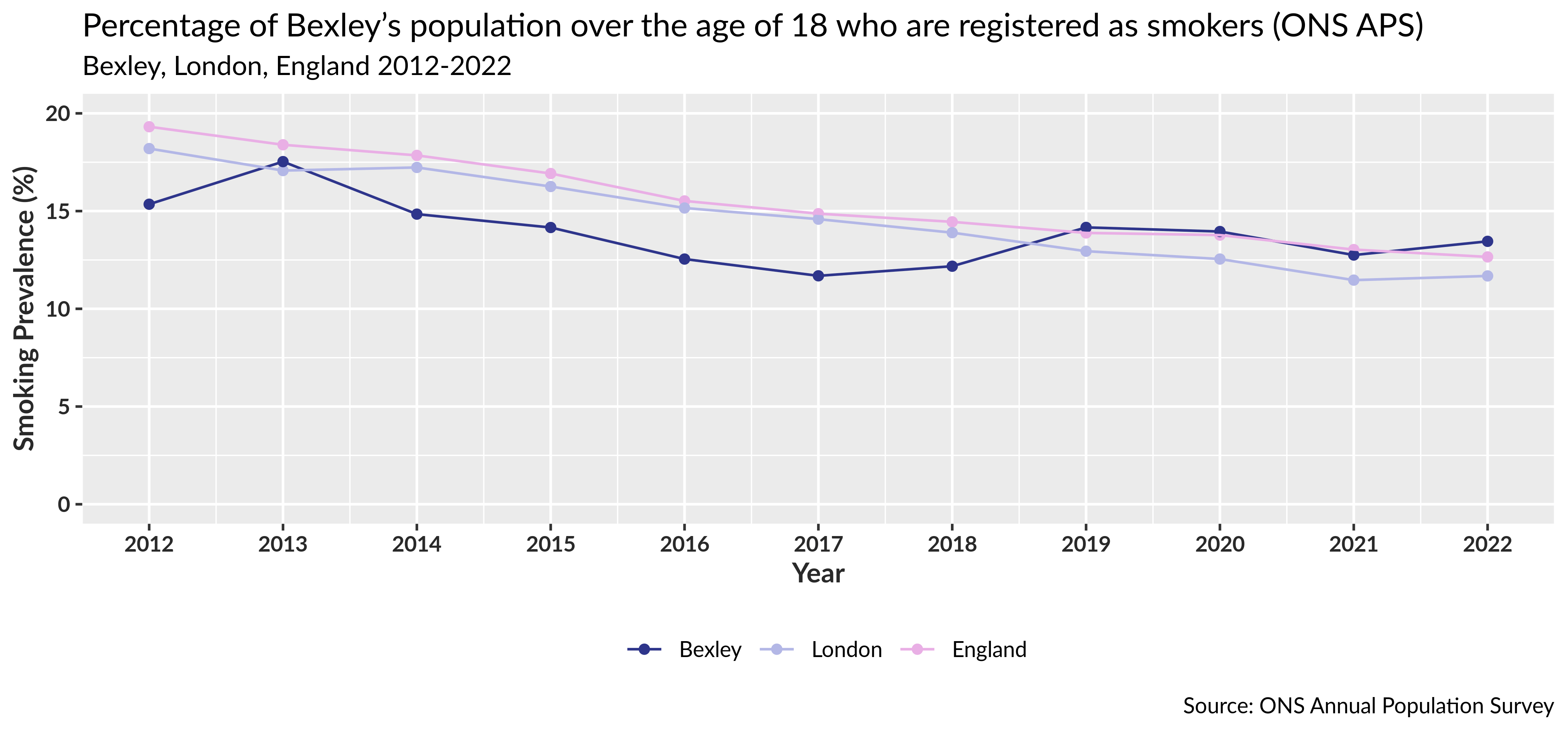Smoking in Bexley
The 2022 Annual Population Survey (APS) estimated that 12.7% of those aged 18 and over in England were current people who smoke, which is made up of 14.6% of all adult males and 11.2% of all adult females. In Bexley, the overall prevalence was 13.5% which would equate to 25,618 Bexley residents, with the borough following a similar trend of higher rates of smoking amongst males, with 14% of adult males compared to 12.9% of adult females. (17)
Figure 1 – Percentage of Bexley’s population over the age of 18 who are registered as smoking (ONS APS)
*The below image of Figure 1 is not suitable for users of assistive technology (Screen reader) and does not allow users to zoom in without degrading visual quality. If you would like to understand any details about this graph, please email public.health@bexley.gov.uk.

Figure 1 shows APS data comparing smoking prevalence in Bexley to the national average between 2012 and 2022. Bexley had a period of 7 years of low smoking rates compared to the national average. Bexley’s rate began to increase in 2018, and in 2019 rose just above the England rate for the first time. The statistics for Bexley and England remained similar until 2022 when Bexley’s rate began to rise even further.
Figure 2 – Percentage of patients registered to GP surgeries who are recorded as smoking by PCN (GPPS)
*The below image of Figure 2 is not suitable for users of assistive technology (Screen reader) and does not allow users to zoom in without degrading visual quality. If you would like to understand any details about this graph, please email public.health@bexley.gov.uk.

GP practices in Bexley are split into 4 Primary Care Networks (PCNs); Frognal, Clocktower, North Bexley, and Apl Bexley. There are 248,059 people registered to GP practices in Bexley. North Bexley is the largest PCN with 102,750 patients registered to its surgeries, which is 41% of Bexley’s registered patients. Data from the 2023 GP Patient Survey (GPPS) presented in Figure 2 estimates that 17.2% of North Bexley’s registered patients are currently smoking, equivalent to 17,673 people. This is a much higher rate than the 3 other PCNs, which have estimated smoking rates of: Clocktower, 9.8% (5,018 people); Apl Bexley, 12.4% (4,843); Frognal, 10.4% (5,726). This would mean that over half of people who currently smoke in Bexley are registered to GP practices in North Bexley.
Figure 2 further shows that in 2023 the estimated prevalence of current people who smoke registered to North Bexley PCN has returned to a level above the England average, having previously trended downwards between 2019 and 2022. Apl Bexley PCN and Frognal PCN show a similar uptick in 2023, whilst Clocktower PCN continues to decrease in estimated prevalence.
Figure 3 – Percentage of recorded people who smoke by GP surgery against areas of relative deprivation in Bexley (IMD, QOF)
*The below image of Figure 3 is not suitable for users of assistive technology (Screen reader) and does not allow users to zoom in without degrading visual quality. If you would like to understand any details about this map, please email public.health@bexley.gov.uk.

Higher smoking prevalence is linked with deprivation and marginalisation. In the UK, smoking is more common among those with a mental health condition, lower income, and fewer or no qualifications, as well as in people who are unemployed, homeless, lone parents, or are in contact with the criminal justice system. Figure 3 compares the smoking prevalence at each of Bexley’s GP practices as recorded on patients’ GP records, with the level of deprivation affecting the surrounding area. Here, deprivation is calculated using 39 social indicators including, but not limited to, income, employment rates, level of education, life expectancy, crime rate, housing affordability, and average distance to schools, post offices, supermarkets, and GP surgeries. As can be seen in Figure 3, GP surgeries with higher rates of smoking are generally situated within the areas of higher relative deprivation, which is consistent with the national evidence.
It is important to note that whilst people registered to a particular GP surgery tend to live in the area surrounding the practice, there is a small proportion of people who live further from their GP, including those that live outside the borough.
